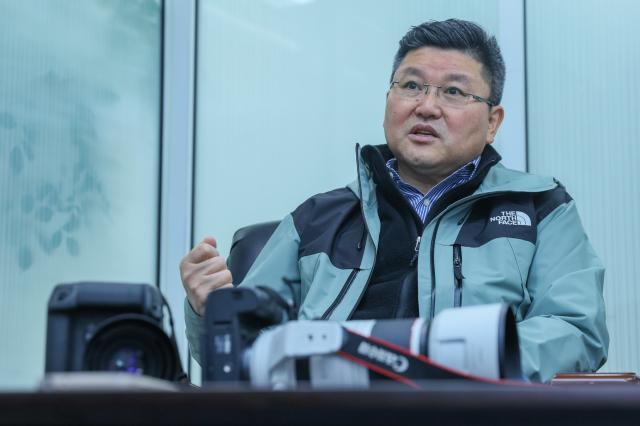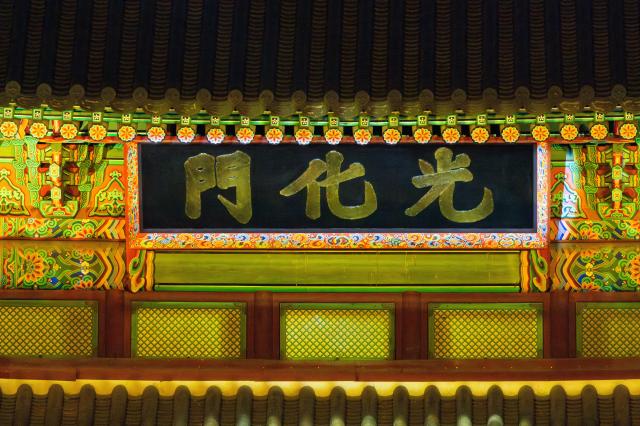
SEOUL -- South Korean-born photojournalist Hyungwon Kang has called for greater efforts to preserve and promote Korean cultural heritage, saying this is not only a matter of national pride and self-esteem, but also a crucial step towards building a sustainable future for the nation.
In an exclusive interview on February 26, the two-time Pulitzer Prize winner said he is currently focusing on capturing the images of Korean cultural assets with journalistic objectivity. He said photographs are not mere images but can be useful tools that embody Korean history and culture. As one of his initiatives, Kang called for replacing traditional Chinese characters on Gwanghwamun, the main gate of Gyeongbokgung Palace in central Seoul, with the Korean phonetic alphabet. Traditional Chinese characters were the sole writing system in Korea before the writing system of the Korean language "hangul" was created in 1443.
Kang thinks displaying the Chinese characters on the symbolic gate where the Hangul was invented is problematic. "If Koreans don't use hangul, who would use it? Using the Korean alphabet for the gate is a way to express historic relevance and ownership of our linguistical identity," Kang said, emphasizing that valuing and preserving one's own culture plays a key role in diplomacy. "We need to become confident and proud of our identity to respond wisely to the demands of neighboring nations."
Kang also highlighted the distinctive features of the Korean language, stating, "hangul expresses almost all sounds we can pronounce and hear." He added: "Among over 7,000 languages worldwide, only about 200 are commonly spoken. Out of these 200 languages, Korean has the largest vocabulary." While the traditional Chinese alphabet consists of more than 60,000 characters, the Korean alphabet is made up of 14 consonants and 10 vowels. Anyone who learned to read and write Hangul can easily utilize up to 11,172 combinations to compose a single Korean syllable.

After immigrating to the United States in 1975 at the age of 13, Kang has worked for major American media outlets such as the Los Angeles Times, the Associated Press (AP), and Reuters. His exceptional work earned him two Pulitzer Prizes, first in 1993 for his coverage of the Los Angeles Riots and then in 1999 for his coverage of a scandal regarding former US President Bill Clinton. In 2001, he served as the White House photographer for President George W. Bush.
Kang returned to South Korea to capture Korean cultural heritage through photography. "I came to South Korea to create informative content targeting English-speaking cultures," Kang said, adding that he often felt offended whenever he perceived that South Korea's history and cultural contributions were underrated in the U.S. He aspires to help future generations of Koreans living abroad in fostering pride and self-esteem in their homeland.
Kang has captured images of over 100 Korean cultural treasures and plans to release a photography collection titled "Visual History of Korea" in 2022. Along with various photo images, the book includes descriptions written in both Korean and English. He recommended the "Bell of King Seongdeok the Great" as a must-see cultural heritage site for foreign tourists visiting South Korea. The gigantic bell, created during the Unified Silla Kingdom (676~935), is located in the southeastern city of Gyeongju. This bell, featuring more than 1,000 inscribed characters, is recognized for stunning carving techniques, as well as its beautiful sound. In 1962, the cultural asset was designated as South Korea's national treasure.
Kang compares photography to writing, emphasizing the importance of understanding the tools and techniques, such as choosing the right lens, to achieve desired results. "I'm always seeking creative ways to capture and narrate situations for a powerful and engaging story," he stressed. With his photography skills, Kang aims to continue his journalism career to deliver insights into Korean cultural artifacts.
Copyright ⓒ Aju Press All rights reserved.


![[Shanghai Expo] Promoting The Beauty of Korean Alphabet, Hangul](https://image.ajunews.com/images/site/img/ajunews/list_noimg.jpg)
View more comments